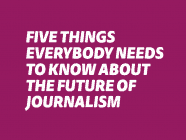It’s clear by now that technology is both saving and destroying journalism. The Internet, tablets, smart phones have decimated the print media’s advertising-dependent business models but had also helped journalists reach new audiences, approach a wider array of sources, and discover innovative ways of telling stories.
Stanford University in California, heart of Silicon Valley and the technology revolution, is encouraging journalists to plug into its networks to discover ways to reinvent their industries.
The John S Knight Fellowships, encourages journalists to become Knight Fellows, and spend a year at the university, working with designers and businessmen to develop technology that will take journalism into the future.
Florenci Prada who runs the Digital Campus program and part of Swissnex Sanfrancisco, a Swiss venture that links Switzerland to Silicon Valley, has picked out some of of her favourite projects by Knight Fellows, ones that bring together reporters, designers, coders and data experts. Her choices are ones that should appeal to reporters in all parts of the globe.
This service deals with the problem of people feeling they do not have time to catch up on the news, by providing a bespoke round up of news on subjects you are interested in. News Concierge will deliver just the amount of news you can take in, during a 15 minute commute, or a 10 minute coffee break.
2) Animated Press.
The 24 hour news cycle is perfect for news junkies, who can follow each step of an unfolding crisis. But for most people, who don’t want to spend their day analyzing each development, the volume of news that accompanies a big, breaking news story is overwhelming. Animated Press uses graphics and animation to illustrate, contextualize and explain a complex story quickly, to someone who has lost the thread of the news story. It starts with the Syrian Conflict in five minutes. The Greek Crisis in four acts is next.
Knight Fellow and photojournalist Sam Stewart tackles one of the most serious issues in his field: the fact that it is now so easy to manipulate photographs that newspaper readers and even experienced journalists cannot be quite sure if what they are seeing is real. Stewart is developing forensic tools that detect manipulation in news photography.
4) Scratch.
Local journalists need to reconnect with their communities if they are to survive. A former editor of the Voice of San Diego tells of how he decided to change the way the newspaper covered local elections. Instead of asking candidates about their policies, his reporters went out and asked residents what issues they were concerned about. He is working on a project to keep journalists and readers engaged for longer, in a more meaningful way, on the stories that really matter to them.
Tags: animated press, digital campus program, Digital Media, i, Innovation in Journalism, Knight Foundation, my news concierge, photomanipulation, scratch, swissnex













































